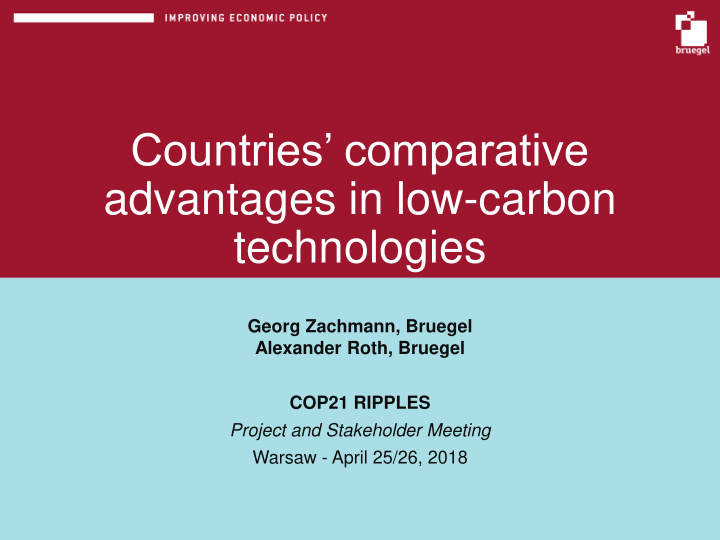



Countries’ comparative advantages in low-carbon technologies Georg Zachmann, Bruegel Alexander Roth, Bruegel COP21 RIPPLES Project and Stakeholder Meeting Warsaw - April 25/26, 2018
A green industrial policy • 2°C – target requires drastic reduction in global emissions • Need technologies that are (almost) competitive with fossil fuels (otherwise incentive to deviate) • Markets underinvest in: • Innovation per se • Technologies that make domestic decarbonisation cheaper • Technologies that make foreign decarbonisation cheaper • Resilient decarbonisation requires a portfolio of technologies -> difficulty of choice 2
Technology choice Learning curves: specialization is necessary Choice of “right” technologies (Regional) policies to enable technology development and deployment 3
Identifying potential strength • Not all countries have potential to grow in all low- carbon technologies • Potential can be assed through: • Current export specialisation • Specialisation in related products • Current research specialisation • Specialisation in nearby technologies • Regional powerhouses 4
Specialization in nearby technologies • Latent factors • Factor cost • Infrastructure • Geography • Domestic market size • …. • Technological links • Similar value chain Mark Huberty and Georg Zachmann (2011), Green exports and • Tech spill-over the global product space: prospects for EU industrial policy • Education • … => All informative about potential 5
Technological Proximity • Related technologies identified by technology proximity • Different measures/technological networks can be used Example: Electric vehicles Power lines Motor railcars Electric power conversion (AC, DC) … Source: Bruegel based on Patstat 6
Potential Strength in Technology • Potential strength is a combination of the • Adjacent technologies and • Network links Figure : Potential Technological Advantage in Solar Thermal 7
Country Example (1) Brazil, RTA (2008 - 2012) and pRTA 1.00 0.90 0.80 0.70 0.60 0.50 0.40 0.30 0.20 0.10 0.00 RTA: Median ± 25% of focus countries RTA (2010) pRTA pRTA: Median ± 25% of focus countries 8
Country Example (2) Brazil, change in technological strength (pRTA – RTA (2010)) 0.55 0.45 0.35 0.25 0.15 0.05 -0.05 -0.15 -0.25 -0.35 -0.45 -0.55 Median (± 25%) of focus countries Change in Technological Strength 9
Conclusion • Need for development in low-carbon techs • Need for specialization • Choice can be determined by many variables • One option: strength in adjacent technologies • Need for (regionally) targeted policies 10
Recommend
More recommend